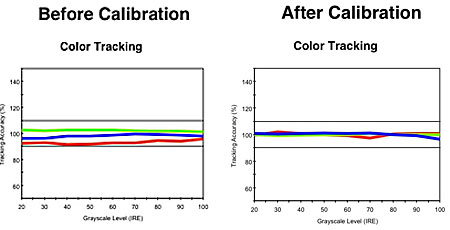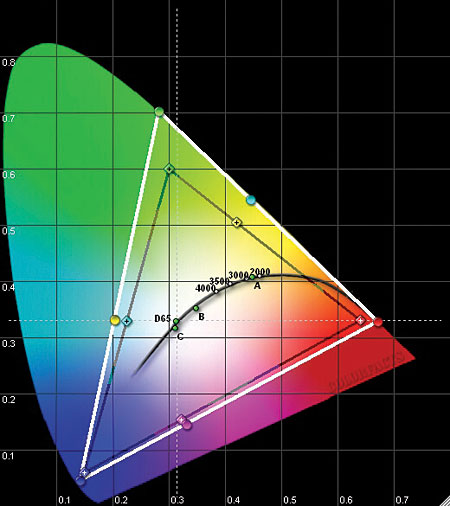DreamVision StarLight1 LCOS Projector HT Labs Measures
Black: 0.0016
White: 18.55
Full-On/Full-Off Contrast Ratio: 11,465:1
Unless noted otherwise, all measurements were taken in User Picture Mode, with the anamorphic lens in place, a full anamorphic stretch engaged (Aspect 16:9, V-Stretch on), the lamp in its High setting, and the aperture (iris) fully open (3). The screen was a 118-inch-wide, Stewart StudioTek 130 G3, which is substantially larger than the screen used for most of our projector reviews. The throw distance was also substantially longer than usual, which put the lens zoom range near its minimum setting. These differences will affect attempts to directly compare the white and black levels reported here with those in most of our other projector reviews.
The full-on/full-off contrast ratio above (which is sometimes referred to as the peak contrast ratio, the sequential contrast ratio, or the dynamic range) is superb and among the best we’ve measured. In the Normal Lamp Power setting, the peak white level dropped to a still impressive 14.05 foot-lamberts, and the black level was 0.0017 ft-L (essentially the same, given typical measurement variations).

The Color Tracking charts show how closely the StarLight1 adheres to the standard D65 white point; the tighter the overlap of the three primary colors, the nearer the result is to D65. The Before Calibration curve was taken with the projector in its Normal lamp mode with the projector on its 6500K Color Temperature set- ting, just as you might use it straight out of the box. The After Calibration setting is fully calibrated, but this time in the High lamp setting.
The Delta E in the After Calibration result was 2.6 or less (mostly less) from 30 IRE (dark) to 90 IRE (near peak white), 1.1 at 20 IRE (very dark), and a maximum of 3.75 at 100 IRE (peak white). (Delta E is a figure of merit that indicates how closely the result is to the ideal white point of D65. Below 4 is good, and below 3 is generally considered visibly indistinguishable from a perfect result.)
An After calibration result was also captured in the Normal Lamp Power setting. While not shown here, the results were marginally better than in the already impressive High setting. A change of lamp mode alters the color temperature and requires a separate calibration. That’s what we did, with User 1 set up for Normal Lamp Power and User 2 for High. This made it easy to shift back and forth as needed by simply switching to the appropriate User setting and changing the Lamp Power separately—Lamp Power is not memorized in the User modes.

The pie-shaped CIE chart clearly shows the StarLight1’s oversaturated color gamut. The correct color gamut (Rec. 709) is shown by the black triangle. Unlike the higher-end StarLights, the StarLight1 has no color management system for reining in this gamut. The result is not accurate color, but it was not unnatural looking, and most viewers will be unlikely to notice anything amiss if the color tracking (gray scale) is calibrated. —TJN

- Log in or register to post comments




































































